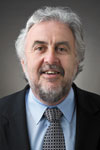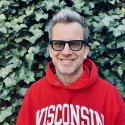Retention: Keeping pace as competition intensifies
Timothy Donohue admits that it’s a good problem to have, but being recognized as a national research leader in a hot field like alternative energy comes with its share of competitive pressure.

Donohue
“The reality is, when you’re a leader on a game-changing research initiative like bioenergy, you’re on everyone else’s radar,” says Donohue, director of UW–Madison’s Great Lakes Bioenergy Research Center. “Bioenergy is a major growth area for the country, so this pressure is only going to continue.”
Having assembled a team of more than 200 people supported by the $125 million Department of Energy project, Donohue’s attention has also turned to keeping the team in place. In the last few months alone, Donohue says three of the center’s top researchers have been targeted for offers by other institutions trying to establish the same reputation UW–Madison enjoys.
Two of those retentions were successful, while one scientist — sustainability expert Jonathan Foley — was recruited away by the University of Minnesota. Successfully retained was biochemist John Ralph, a global leader on the challenge of removing lignins from biofuels, who received “unprecedented” offers from other institutions.
Donohue’s research center is a prime example of what’s at stake as UW–Madison works to retain its best talent in the face of growing international competition and a spike in faculty retirements nationwide. The worldwide demand for higher education seats is expected to double by 2025 to 200 million seats, and competition for available faculty will accelerate in kind.
While UW–Madison received high-profile publicity in the past year suggesting the campus has been hit disproportionately hard by outside offers, new data compiled by Provost Patrick Farrell’s staff tell a different story: UW–Madison is holding its own on the faculty recruitment and retention front.

Farrell
The fall 2008 study indicated that UW–Madison continues to retain about 68 percent of faculty who receive outside offers, a rate that is consistent with recent history and with the rates of peer institutions. New hires are also competitive, with the campus achieving a 70 percent acceptance rate among new faculty receiving offers.
Overall faculty numbers also have remained relatively stable. The faculty headcount in 1998 was 2,135, compared to 2,198 in fall 2007, Farrell’s study found.
What is causing concern, however, are budgetary and demographic trends that will continue to stress UW–Madison’s ability to stay competitive in the years to come. UW–Madison is retaining more than two-thirds of faculty with outside offers in spite of the fact that retention pressure has essentially doubled since 2003 — from 2–2.5 percent of all faculty five years ago to 4–5 percent today.
At the November meeting of the UW System Board of Regents, Farrell noted that the increasing costs of recruitment and retention have eaten into the university’s base budget. For example, covering the costs of faculty startup packages has grown more expensive and has created a $5 million shortfall that must be covered from the university’s base budget, he says.
Chancellor Carolyn “Biddy” Martin says a core problem overriding all of these issues is the lack of competitiveness in faculty salaries. UW–Madison ranks at the bottom of its 12-campus peer group on salaries and is $13,500 below the median for full faculty. Martin says one of her top priorities will be to elevate UW–Madison faculty salaries to the median of its peer group.
“The fact that we can say that things are not deteriorating in spite of low salaries right now is remarkable, but a continuation of these circumstances puts us more and more in jeopardy of decline,” she says.
Martin says the state’s $10 million investment in high-demand faculty last year has been extremely valuable, and the UW Foundation’s commitment to fundraising for faculty support provides additional strong tools for retention. But larger systemic problems, such as the growing inequity between faculty who receive retention offers and their equally talented peers who haven’t entertained outside offers, must be addressed through a competitive pay plan.
Martin says that goal can be addressed over multiple biennial budgets, especially as the state faces a time of extreme economic hardship. But there also are smaller-ticket remedies and nonbudgetary aspects of UW–Madison that matter in attracting and keeping talent.
Under discussion in the next biennial budget are some strategic measures that could help at a lower cost to the state. Those include greater support for graduate student tuition; converting the $10 million high-demand faculty fund into a permanent line item; increasing the fund that supports faculty startup costs; and providing domestic partner benefits.
“There are issues of departmental culture and intellectual culture that are also very powerful attractors,” Martin says, noting the university’s commitment to academic freedom, interdisciplinary work and the Wisconsin Idea. “So there are things we can do that don’t require money per se, but require the effort to create an environment in which people feel they can flourish.”
Campus culture made a difference for English and African studies professor Teju Olaniyan, who turned down an offer from Cornell University this year to stay at UW–Madison. “One of the biggest strengths of UW–Madison, for me, is the vast spread of treasured colleagues across disciplines working in or near my areas of teaching and research,” he says. “Having such a critical mass is extremely important to me. It was the reason I came here from the University of Virginia years ago.”
Although the humanities have been hit with lost faculty lines this decade, Olaniyan expressed “confidence” that the chancellor and administration can address the problem.
Gary Sandefur, dean of the College of Letters and Science, has, like many deans, been paying close attention to those faculty most attractive to outside offers. Through the use of the high-demand faculty fund and the college’s innovative privately funded Faculty Fellows initiative, Sandefur has been able to deploy a “pre-emptive strike” approach to reward highly productive faculty before they are targeted by others.
“The real competition is for the people who are one or two years beyond tenure,” says Sandefur. “What they’ve done is they’ve already proven themselves, they’ve established a reputation, and they’re known around the country and sometimes the world for their work. But they’re paid relatively low compared to full professors, so they are very, very attractive to people who want to get someone on the way up.”
History professor Jeremi Suri, one of more than two dozen L&S faculty to receive such offers, says the gesture is important professionally and personally. “This initiative has made it possible for me to plan for a long, productive career at the university, as well as a comfortable life for my family in Madison,” Suri says. “Instead of devoting my time and energy to the investigation of lucrative opportunities at other institutions, I can focus my daily activities on the research, teaching and public engagement that I love.”
Martin says the severe economic woes faced by the state and nation will require the university to be more creative in addressing the recruitment and retention challenge. But it is too important to the university’s future to allow declines.
“We’re going to remain committed to our public purposes and contribute everything we can to the benefit of the state of Wisconsin,” Martin says. “But we can’t continue to make those contributions if we don’t remain pre-eminent. And we can’t remain pre-eminent without great faculty.”
Tags: faculty and staff



